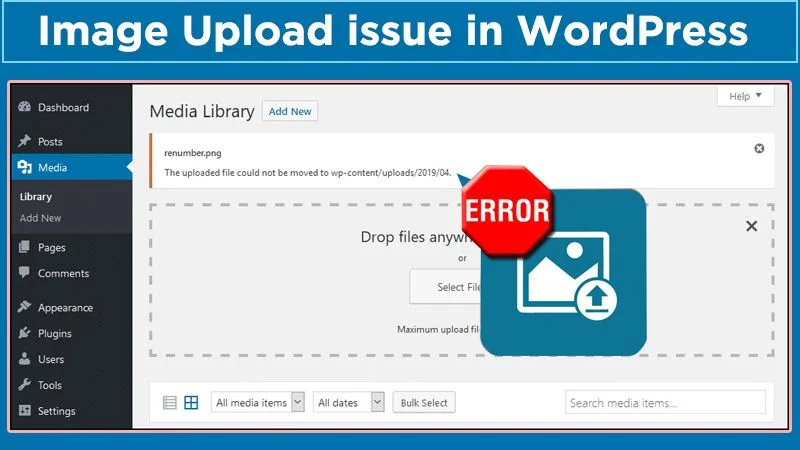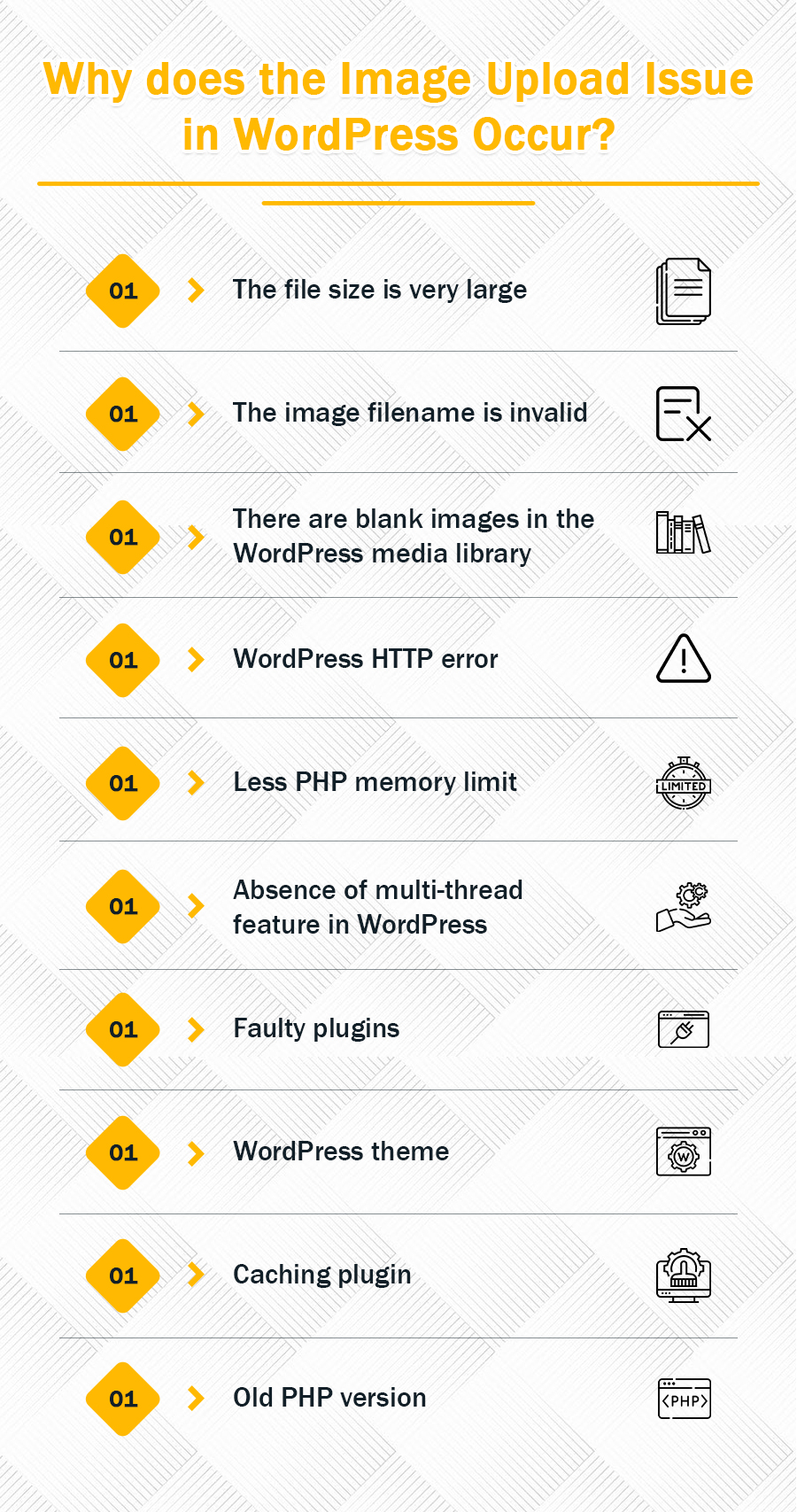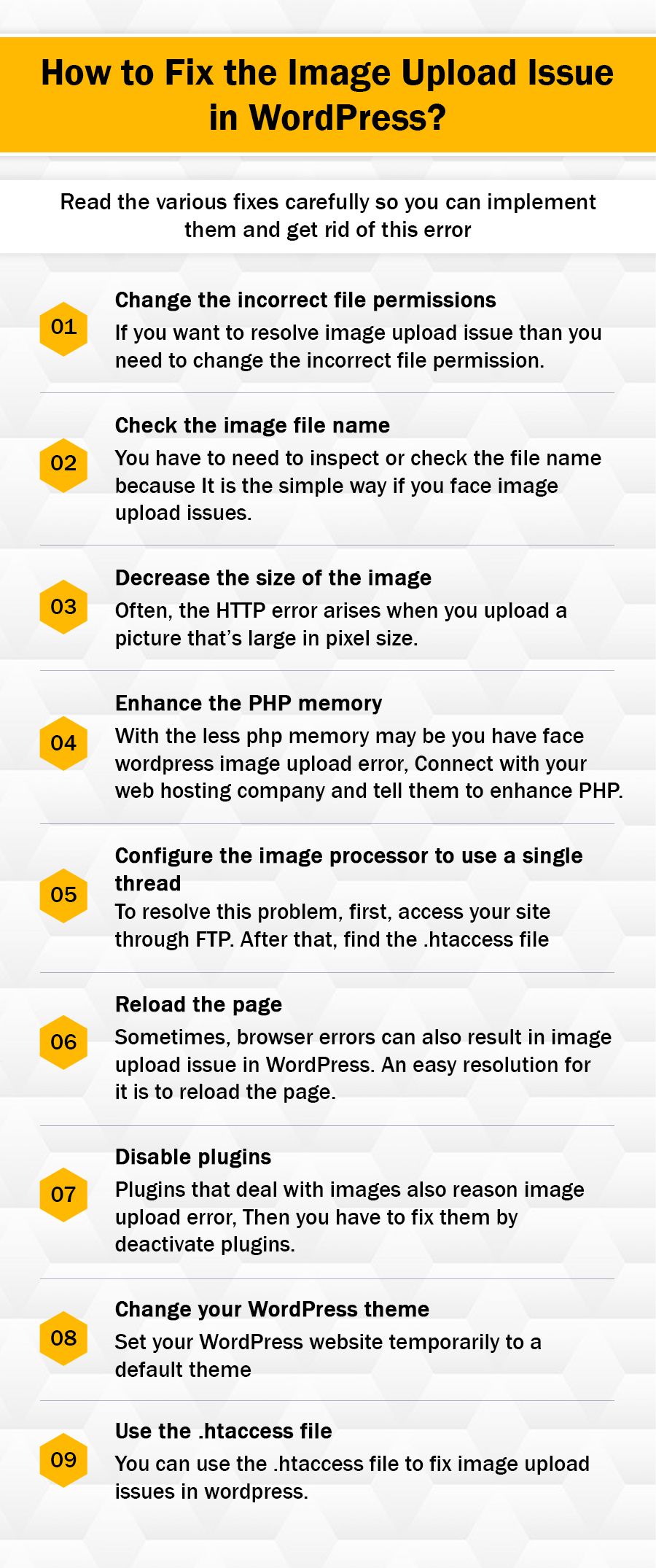
Image Upload issue in WordPress: Ways to Fix it
Do you face problems in uploading images on your WordPress site? Well, the issue is quite common, especially among beginners. The image upload issue in WordPress is undoubtedly quite bewildering. The error occurs without any warning and without the user modifying anything on their website. It can take lots of time and effort to discover the underlying cause of this error. Fortunately, this problem, being a fairly common one, has various fixes. In fact, many of them are quite easy. So, you can quickly implement the measures and start uploading images on your site. In this article, you’ll find how to fix the image upload problem on your WordPress website effectively.
What Does the Image Upload Issue in WordPress Mean?
Beautiful and captivating photos are imperative for any website on a WordPress content management system. It helps them attract more people and retain their interest in the site.
Images are especially important for an E-commerce site. These sites should have clear product images. After all, it’s the presence of the pictures that help people to find more about the product. The clearer the image, the better will your customer be able to understand the product. Based on it, they’ll make the decision about buying it or not. So, it’s safe to say that images drive sales.
But uploading images to the WordPress website does not turn out to be a smooth ride. The content management system will show the WordPress image upload error at various points. Note that this problem is quite challenging to diagnose. It’s because various factors trigger. So, the user may not know where to start fixing the issue. Most commonly, the upload issue is a result of incorrect or faulty file permissions. But the great thing is that by learning the causes of this problem, you can take the appropriate rectifying measure.
Why Does the Image Upload Issue in WordPress Occur?

As mentioned before, you can’t upload images to WordPress mainly because of faulty file permissions. The WordPress files in your web hosting services require particular file and directory permissions to operate. The wrong ones hinder WordPress from uploading files on your WordPress server. So, you receive the following error message:
‘Unable to create directory wp-content/uploads/2019/04. Is its parent directory writable by the server?’
You can also see the following message:
‘The uploaded file could not be moved to wp-content/uploads/.’
But apart from incorrect file permissions, there are also other factors that can result in WordPress HTTP error image upload. These include the following.
- The file size is very large – If a particular image file size is too much, you will not find the image uploading on the site. The file size goes beyond the maximum upload size, thus preventing you from uploading an image. This can only be resolved when you raise the limit of image upload size.
- The image filename is invalid – Another prominent reason for this image upload problem is an invalid image file name. If the file has special characters like dollar, hashtag, or asterisk, it will not upload. Accent letters in the file also prevent it from uploading.
- There are blank images in the WordPress media library – Another likely cause of HTTP error image upload WordPress is the presence of blank images in the WP media library. You must ensure that the upload folder has the correct permissions.
- WordPress HTTP error – Many people reference an HTTP status code with web browser errors. But when a WordPress HTTP error occurs, it will result in this problem. Those who are unaware of the usage of debugging mode in WordPress face a very difficult time resolving it.
- Less PHP memory limit – If your PHP memory limit in WordPress is low, it’s highly likely that you won’t be able to upload images. Restricted server resources can influence the way applications operate. It results in various errors with WordPress. The image upload issue is one of them.
- Absence of multi-thread feature in WordPress – The default image editors in WordPress can handle pictures that employ multiple threads. It accelerates image processing. But all web hosts do not allow this feature. So, it results in the image upload issue in WordPress. So, you need to make necessary modifications to the .htaccess file.
- Faulty plugins – Its also a fairly common cause of this error. Some plugins that handle images can cause unintended problems. In such a case, you need to find the faulty plugin.
- WordPress theme – If you are using any other theme except the default one, it’s likely that it may be causing the problem. In this instance, you need to change the problematic theme and install another one in its place.
- Caching plugin – If you are using a caching plugin, you may face problems in uploading images on your WordPress website. A caching plugin is known to cause a few problems.
- Old PHP version – Are you using the latest PHP version? If you are using a PHP version lower than 7, it’s likely that you’ll face issues in image upload. WordPress recommends you to have PHP 7.4 at the least. So, if you use a version lower than 7, you should think of updating it to the latest one.
How to Fix the Image Upload Issue in WordPress

As there are so many causes for this image upload problem in WordPress, there are many resolutions as well. Read the various fixes carefully so you can implement them and get rid of this error.
1. Change the incorrect file permissions
To fix the HTTP error WordPress image upload, you need to change the file permissions. You can do that by using an FTP client. Follow the steps below to change file permissions using it.
- Link to your website through FTP. Now, navigate to /wp-content/folder.
- Locate the ‘Uploads’ folder. WordPress stores your media uploads here.
- Right-tap the Uploads directory and choose ‘File Permissions.’
- You’ll see a dialog box of file permissions.
- Firstly, set file permissions for both the uploads directory and all the subdirectories within it to ‘744.’
- To do it, input ‘744’ in the box of numeric value. Then, tick the box beside ‘Recurse into subdirectories’ option.
- Hit the ‘Apply to directories only‘ button.
- Tap ‘OK‘ for applying these changes.
- Now, you’ll require to set the file permissions for every file in the uploads directory.
- To do it, right-tap the uploads directory and choose ‘File permissions.’
- In the dialog box of file permissions, modify the numeric value to ‘644.’
- Tick the box beside the ‘Recurse into subdirectories’ option.
- Lastly, tap the ‘Apply to files only‘ button.
- Tap ‘OK‘ to apply the changes.
2. Check the image file name
A simple fix for the image upload issue in WordPress is inspecting the image file name. Remove any special characters in it, and then try to upload it. If this fix works, you don’t have to spend time using other lengthier fixes.
3. Decrease the size of the image
Often, the HTTP error arises when you upload a picture that’s large in pixel size. For instance, a 3000 X 2000-pixel image is too large for the server to process properly. In fact, some servers display an error even when your picture is below 3000 X 2000 pixels. Some possible resolutions to decrease your image size are as follows:
- If you are a Mac user, utilize the Preview App to minimize the image size.
- Utilize the Paint Application if using a PC.
- The size of boxed slider image is 1170px X 500px in Customizr Pro theme. Minimize your image to this size before you upload it.
- Minimize the picture size by trial and error till you can upload it without any issue.
4. Enhance the PHP memory
With a low PHP memory, WordPress can’t upload images. Connect with your web hosting company and tell them to increase the memory limit of your PHP. The limit should be increased gradually till you can successfully upload an acceptable image size. It should have a width of at least 2000px.
You can also try increasing the memory limit of PHP by yourself. Add the define( ‘WP_MEMORY_LIMIT’, ‘256M’ ); code line in your wp-config.php. But it will only work for you if your hosting package has this much memory amount. Again, you should increase the memory limit gradually till you can upload an image of a size acceptable to you.
Apart from the fix above, you can also try enhancing the memory by adding the php_value memory_limit 256M command line to your .htaccess file. But this will also work only if you have this amount of memory in your hosting package.
If you can access the php.ini file of your web server, you can locate the memory _ limit. Then, you can increase its size. To increase the file size, paste the memory_limit = 256M command.
5. Configure the image processor to use a single thread
Imagick is one of the image processors that WordPress uses to deal with images. As mentioned before, the processor can use multiple threads to make image processing speedy. But the multi-thread functionality is not permitted by some web hosts. If your web host is one of them, you’ll face the can’t upload images to WordPress HTTP error.
To resolve this problem, first, access your site through FTP. After that, find the .htaccess file. Once you find it, edit it and incorporate this configuration: SetEnv MAGICK_THREAD_LIMIT 1. After that, upload images and see if you are still facing any problems.
6. Reload the page
Sometimes, browser errors can also result in image upload issue in WordPress. An easy resolution for it is to reload the page. It may feel like a very simple fix, but there are some valid reasons to try it out.
- WordPress may lose connection with the browser. Consequently, the process fails. It can be a result of a problem with the internet service provider, a temporary problem with your WordPress host, and the like.
- Often, the login session with WordPress expires without you knowing about it. When this happens, you get kicked out after reloading the page. So, it’s important to log in again.
7. Disable plugins
Plugins that deal with images can also cause the image upload issue. For this reason, you need to deactivate plugins and then try to upload the file. Most often, image optimization plugins are behind this problem. So, if there’s any such plugin, you need to disable it temporarily and try to upload the image again. Find an alternative plugin if you find the error resolving after plugin deactivation. To get more help on this issue, connect with the plugin developer.
8. Change your WordPress theme
It may be possible that you are facing WordPress image upload error because of your WordPress theme. To find if the theme is the culprit, fist create your site’s backup. Then, set your WordPress website temporarily to a default theme. Now, try to upload the image. If it uploads successfully, it means that your theme was causing this problem. So, look into an alternative theme.
9. Use the .htaccess file
WordPress uses a .htaccess file in it to manipulate the way Apache serves a file from the root directory and subdirectories. Thus, .htaccess is very crucial, and you shouldn’t edit the original content of this file. However, you can incorporate some directives at the end of it to raise the PHP upload max file size.
- Access your WordPress installation using your FTP program.
- Navigate to the root directory. Here you can locate your wp-config.php file. You must be able to locate the .htaccess file.
- Download its copy on your computer.
- Open it and add a new line at the end of the file.
php_value upload_max_filesize 64M
php_value post_max_size 64M
php_value max_execution_time 300
php_value max_input_time 300
- Save the changes. Then override the .htaccess file on the server.
- Navigate to ‘System Information’ and see if the values have been modified. If they haven’t, contact your hosting company for help in editing them.
Conclusion
After reading this post, you can confidently resolve the image upload issue in WordPress. There are numerous fixes, so don’t panic if a few of them don’t yield the results. You’ll be able to understand the issue better after you follow the various fixes. However, if the image upload problem doesn’t resolve even after implementing all the resolutions, contact WordPress support services. The professionals will easily diagnose and fix the problem you are facing.
Tagged with: can't upload images to wordpress how to fix image upload issue in wordpress wordpress can't upload images wordpress cannot upload images wordpress file upload wordpress images not displaying wordpress images not showing-
On Time Delivery
- 50
Discount
-
24×7 WordPress Support
-
Cost Effective Services
-
Skills Wordpress Developers
-
100% Satisfaction